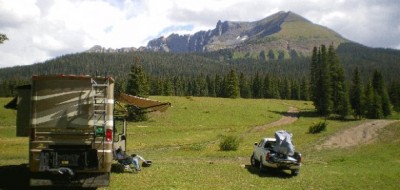By Bob Difley
In last week’s post I wrote about the wise use of water and how its conservation can help extend your boondocking days before having to refill your water tank. This week (I know you’ve been waiting for this part) comes the inevitable yucky part of boondocking, dealing with waste water. Gray water waste disposal (waste from your sinks and shower) is not so bad but you also have to deal with the blackwater tank disposal–that’s what goes into your tank from the toilet.
The main difference between boondocking and hookups regarding waste tanks is the length of time the yucky stuff stays in the tanks. Hookups, very short. Boondocking, long. In fact one of the goals of boondocking is to stretch out the length of time between dumping your tanks, so you want to keep the effluent in the tanks as long as possible before you have to abandon your campsite.
That means that when boondocking you should:
- Regularly monitor the gauges indicating the levels of each tank.
- Have an general idea of the tank levels just to affirm that your gauges are correct.
- Determine how fast your tanks are filling and how much time you have left before you need to dump.
- Install a venturi-type roof vent to your black water tank vent to extract odors. No chemicals needed.
- Move to a dump station before your gray tank bubbles up into your shower.
- Use conservation habits to empty as little into your holding tanks as possible.
- Dump your tanks into a portable holding tank (sometimes called a Blue Boy) and transport it to a dump station rather than moving your whole rig. If you are in a no-hook-up campground with a dump station, you can tow the Blue Boy for short distances.
The other trick for extending your boondocking days between runs to the dump station requires new ways to deal with water usage. The black water tank will not likely be the limiting factor to your boondocking days since the gray tank fills faster. Other than the amount of water you use to flush the toilet (be conservative) the emphasis should be put on the gray tank. Using the tips in last week’s post on conserving the use of water will naturally also put less into your gray tank.
Some other ways to reduce the flow into you gray tank include:
- Wipe all food off dishes and pans before washing so food does not get into your wash water.
- Wash dishes in plastic dishpan and when finished dump on a thirsty plant.
- Rinse dishes collecting water also in a plastic tub and also pour on a tree or plant.
- Save water in a bucket or tub when running shower to warm it up and use to flush toilet.
- Fill a Sun Shower from a stream or lake and use for outside showers.
- Never leave a faucet running into a sink and then into the drain to the tank. Always collect running water and use for other things, like for brushing teeth, cooking spaghetti, making coffee, drinking, etc.
You may wonder about the ethical or legal consequences of pouring your used gray water out on the ground or on a bush. This is always a subject of debate among boondockers and does not have simple black and white answers. After contacting the Arizona office of the BLM on this question, I received the following reply:
. . . if the gray water creates a hazard or a nuisance a Law Enforcement Officer can cite (or in extreme circumstances arrest) an individual. This would go beyond simple gray water dumping, and the citation would likely be for some other offense related to degradation of resources or public health and safety issues. Law Enforcement Officers in the field have discretion in applying the laws and regulations . . .
For more RVing articles and tips take a look at my Healthy RV Lifestyle website, where you will also find my ebooks: BOONDOCKING: Finding the Perfect Campsite on America’s Public Lands, 111 Ways to Get the Biggest Bang for your RV Lifestyle Buck (PDF or Kindle), and Snowbird Guide to Boondocking in the Southwestern Deserts, and my newest, The RV Lifestyle: Reflections of Life on the Road (Kindle reader version). NOTE: Use the Kindle version to read on iPad and iPhone or any device that has the free Kindle reader app.

